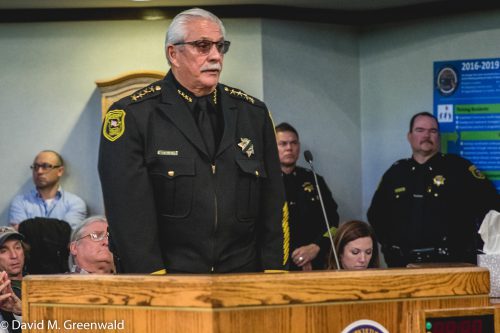
Two weeks ago when Yolo County Sheriff Ed Prieto spoke before the Yolo County Board of Supervisors he told the board that the proposed MRAP (Mine Resistant Ambush Protected vehicle) would be used only as a defensive vehicle, providing a shield for deputies during active shooter or hostage situations.
He specifically told the board that it would not be used in protests or to round up immigrants in an ICE (Immigration and Customs Enforcement) operation.
But, leaving aside the issue of the longevity of the sheriff who is in his 70s and the views of this sheriff potentially differing from that of his successor, there are questions as to how credibly the sheriff can commit to these pledges.
One of the potential uses is by “Homeland Security.” During the board meeting, Don Saylor made a note of this and asked the sheriff about it. Sheriff Prieto said that he was not going to get involved in any Department of Homeland Security (DHS) issue that involves deportation of undocumented immigrants.
While the sheriff has a good record on this during his tenure as sheriff, the question is whether ICE would have the legal authority to appropriate an MRAP.
As the staff report notes, “The National Defense Authorization Act of 1997 allows for the transfer of excess Department of Defense property, that might otherwise be destroyed, to law enforcement agencies across the United States and its territories for use in counter drug and terrorism activities.”
No one seems to have an answer as to whether the Department of Homeland Security, with ICE under DHS, could appropriate the use of such a vehicle.
And, even if they don’t, we still have the situation in Santa Cruz that we reported on recently. For instance, law enforcement officials in Santa Cruz have accused federal agents of using a gang investigation as cover for an immigration raid.
In a press conference a week ago, the Santa Cruz Police Chief noted that they would not have “participated or cooperated in this operation if we had known that it included immigration enforcement.”
He went so far as to say that he had assurances from DHS that the raid did not have an “immigration component.”
But that is not what happened. Police would learn that DHS officials “had acted outside of the scope of this operation and had detained and removed a number of individuals from various locations based upon their immigration status.”
So that scenario could now play out here – you would have a case where the MRAP is authorized for potential DHS operations, the sheriff’s department could cooperate with DHS, believing that the operation involved something other than immigration, and then be surprised to learn that there was an immigration round up using the MRAP.
You think that is far-fetched? That is essentially what happened in Santa Cruz, which is a sanctuary city and doesn’t cooperate with the federal government on immigration matters.
It is hard to know what to make of this, but we now have a story published in the Sunday San Francisco Chronicle about a 14-year-old boy from Honduras who has been held in the Yolo County juvenile hall for almost a year AFTER he was granted asylum.
The Chronicle reports, “A boy who made his way alone across the U.S. border last year to escape extreme domestic abuse in Honduras has been locked up in a Northern California juvenile hall for nearly a year, even though he has no criminal record and has been granted asylum.”
Why this has not been reported locally is an interesting question, but Beth Gabor, the Yolo County Public Information Officer (PIO), told the paper that “the county’s contract with the federal government prohibits local officials from discussing specific cases.”
So the county has an agreement with the federal government to hold people in its detention center?
Here’s what we know:
“155,000 children have crossed the nation’s southern border alone in the last three years, the majority of them fleeing violent gangs, poverty and domestic abuse in El Salvador, Guatemala and Honduras. Nearly a fifth of the unaccompanied children who arrived last year were age 12 or younger, according to the Office of Refugee Resettlement.
“Typically, they are released to relatives within about a month. A small fraction of the children, those who are found to have a criminal history or who pose a flight risk or a danger to themselves or others, are placed in locked facilities.
“In Northern California, unaccompanied minors are housed at two shelters in Solano and Contra Costa counties, and 30 beds are reserved for them in the Yolo County juvenile hall. That facility is the only locked setting for unaccompanied minors in the state.”
Holly Cooper, who is the “co-director of the Immigration Law Clinic at UC Davis, says unaccompanied minors have few legal remedies, and, like G.E., can find themselves indefinitely detained. But she said G.E.’s case is particularly disturbing because he remains locked up despite facing no criminal charges and no pending deportation order.”
“We don’t believe that his confinement is constitutionally or legally justified,” she said.
I do not think anyone knew this kind of stuff was happening in Yolo County, but it underscores, at least for me, that there are no assurances when it comes to these types of matters.
To summarize: we need to know in advance what the actual rules are – can outside federal agencies appropriate the use of these vehicles and other military equipment? What kind of safeguards do we have?
Personally, I oppose the use of military vehicles for civilian use. I am sympathetic to the need for armored vehicle in live shooter and hostage situations, even if they are likely to be relatively rare. But I think the chance of those situations are remote and certainly, with a vehicle already in Woodland, I don’t really see the comparative advantage of having three vehicles versus two in Yolo County.
—David M. Greenwald reporting






Nope.